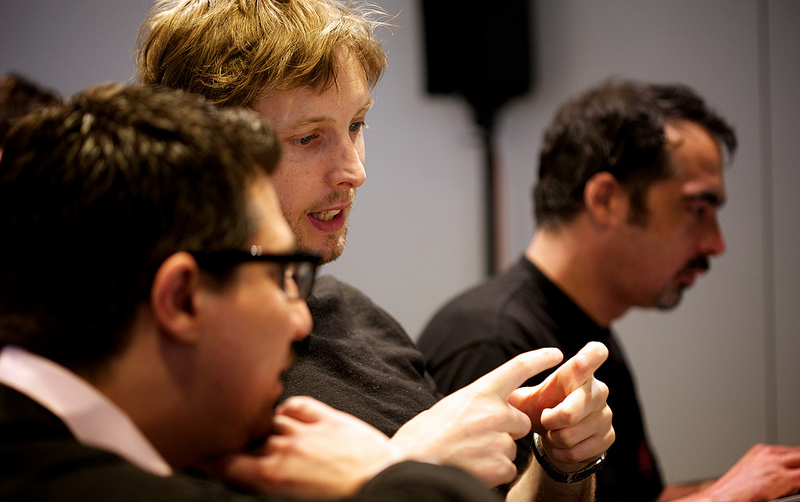
Meeting by Financial Times | CC BY 2.0
In the last two posts of our Success with Mobility series, I discussed the importance of leadership and talent in mobility projects. When we consider how to achieve success with mobility, we can’t deliver business value unless we make users the focal point of our mobility strategy and execution.
I strongly believe that mobility demands user focus, allowing you to become closer to your current and potential users. However, a one-size-fits-all approach doesn’t take into account many attributes that will be unique to each of the environments we operate in, and may result in shortsighted decisions. User-centric practices such as design seek to create every opportunity for greater interaction right from the onset of our engagements.
User Focus Starts with Business Value
Ultimately, it all boils down to these questions: What is the business value for mobility? What will you gain? Is it insight into operations? Is it improving productivity through the use of everyday business tools on mobile platforms? What cost savings can we achieve through mobile-driven processes? Is it increased sales as a result of better-managed opportunities?
A successful, user-driven mobility strategy will incorporate all of these objectives. Crucial decisions made during development will directly guide and influence the outcomes to many of these questions.
If your team has established the link to their overall strategy, while considering the relevance of mobility solutions and understanding their context, then you have all the right ingredients to effectively deliver business value. This may sound simple, but I often find that this is where the first oversight happens—not because we lack the knowledge, but because we make the wrong assumptions.
Do We Really Know Our Users?
Generally, this question is taken for granted. People assume that anyone can be a mobile user at the flip of a switch. Although this may be true, the learning curve can be vastly different depending on our users’ background and how mobile savvy they are. The question is not whether individuals can become mobile users, but whether they can quickly become mobile transformers and drive the project to success—especially if they play a key role on the project team. Therefore, it is critical to gauge users’ overall mobile readiness and willingness.
In many cases, their attitude (which is how they perceive the mobile device, the mobility project, and its value to the business) is more critical than their technical knowhow—or lack thereof. Technical ability can be learned, but it is very difficult to counter an individual’s long-held assumptions.
Getting Closer to Our Users is the Only Way
In addition to understanding who the users are, teams need to understand what they do today with their mobile devices and what they will be doing tomorrow after the rollout. The fact that potential users utilize smartphones in their personal lives doesn’t guarantee a successful adoption of a mobile solution.
The user experience needs to be actively considered from day one. Closely observing current and potential users’ mobile interactions can help validate your assumptions about mobile usage and effectively identify where gaps may exist.
To create an effective mobile strategy, research cannot be accomplished from behind a desk. As content marketers, we need to work side-by-side with our customers, in the same environment and under the same conditions in order to fully understand what it’s like to be in their shoes. Getting closer to our mobile users means making every effort to look at the mobile experience from their perspective.
Bottom Line: Understanding our users at all levels–not just who they are–is critical to the success of a mobility project. This deeper level of insight and sense of urgency sets the right expectations and assumptions for the teams who will design and develop the solutions. When you demand user focus, you set your mobility projects up for success.
How do you make users the focal point of your mobility strategy and execution?
 Kaan Turnali is Global Senior Director, Business Intelligence (BI) at SAP. He is responsible for the development, oversight, and execution of strategy for the BI platform across SAP’s Global Customer Operations (GCO) Reporting & Analytics Platform. In addition, he manages special mobile BI projects for the Office of the CEO and the GCO senior management team.
Kaan Turnali is Global Senior Director, Business Intelligence (BI) at SAP. He is responsible for the development, oversight, and execution of strategy for the BI platform across SAP’s Global Customer Operations (GCO) Reporting & Analytics Platform. In addition, he manages special mobile BI projects for the Office of the CEO and the GCO senior management team.
Prior to joining SAP in 2006, Kaan worked as a senior BI consultant specializing in strategy, design, and development of enterprise BI solutions for SMB and Fortune 500 companies. His background and experience in the integration of business and technology span over two decades. He is an adjunct professor, teaching BI in the doctor of business administration program at Wilmington University.
Social Media Info:
Twitter: @KaanTurnali https://twitter.com/KaanTurnali
LinkedIn: http://www.linkedin.com/in/kaanturnali
Company Website: www.sap.com
Personal Website: www.turnali.com


Comments are closed.